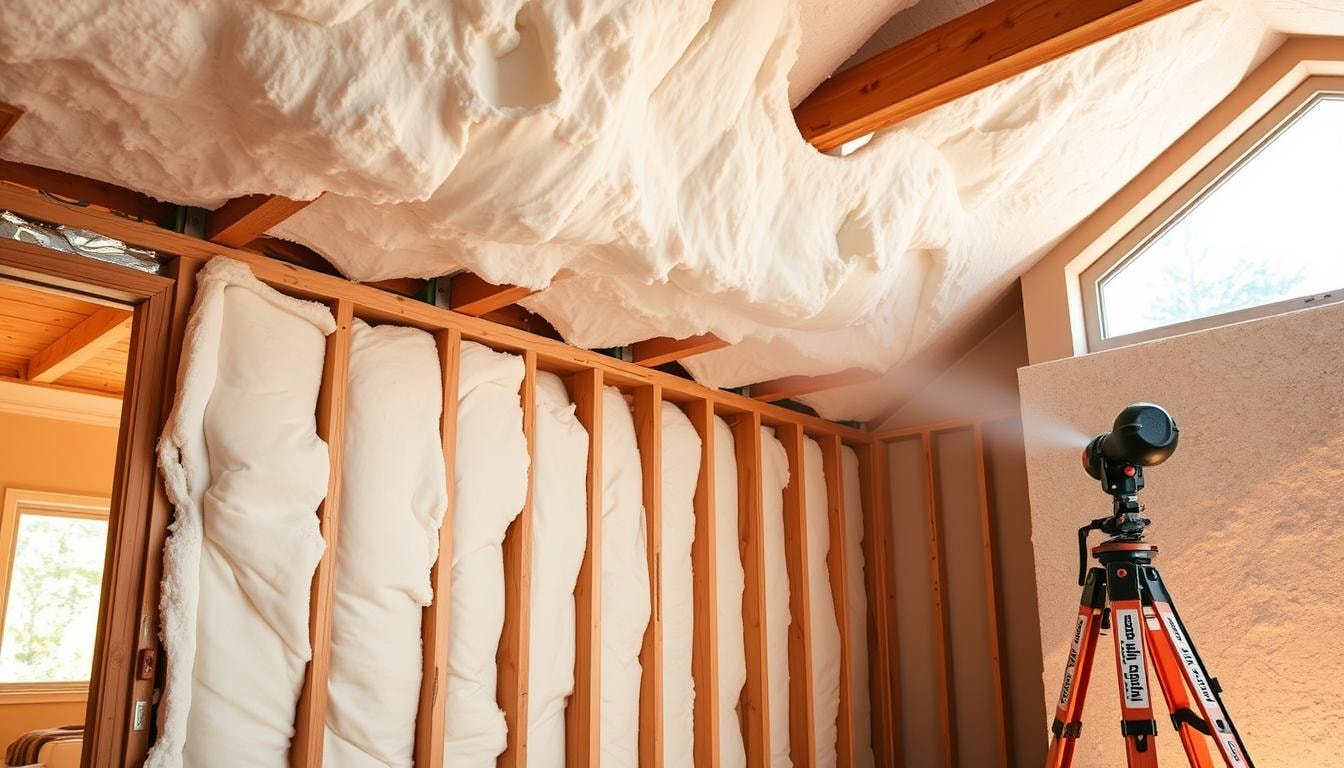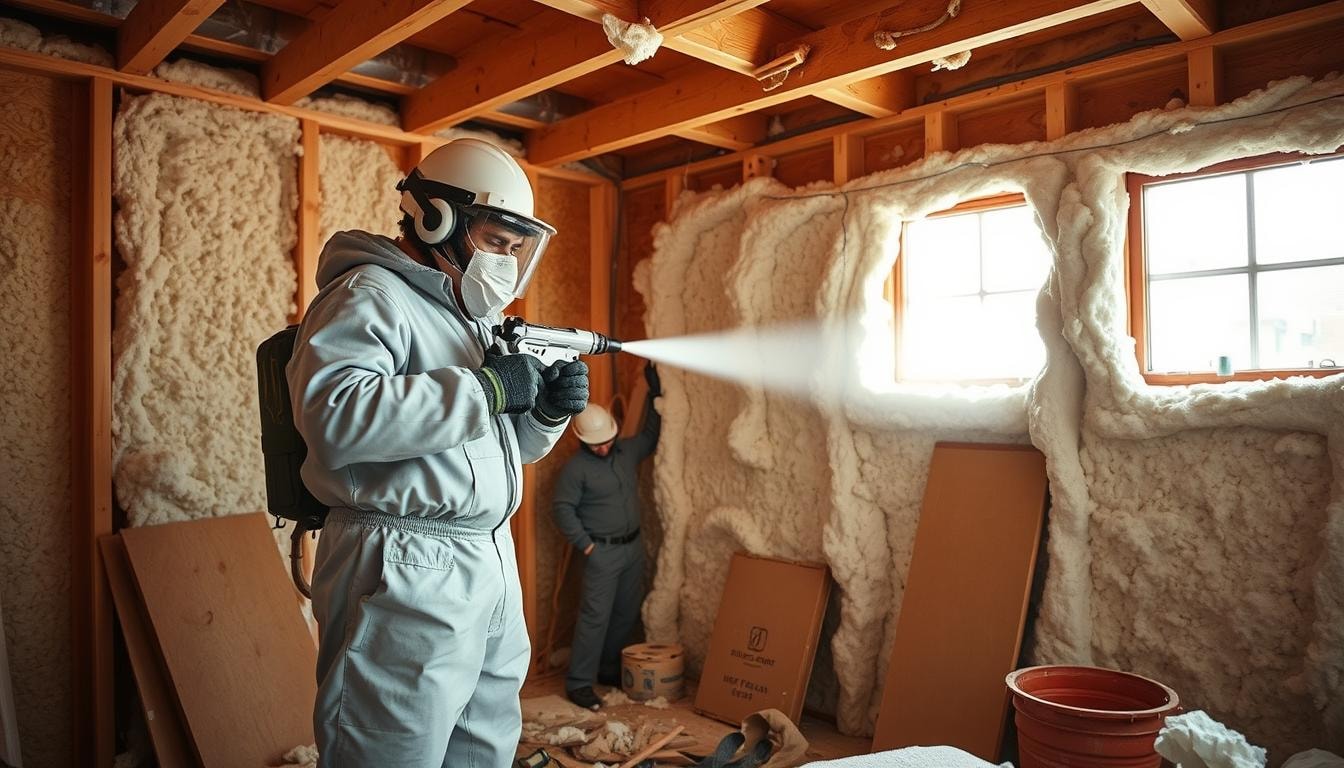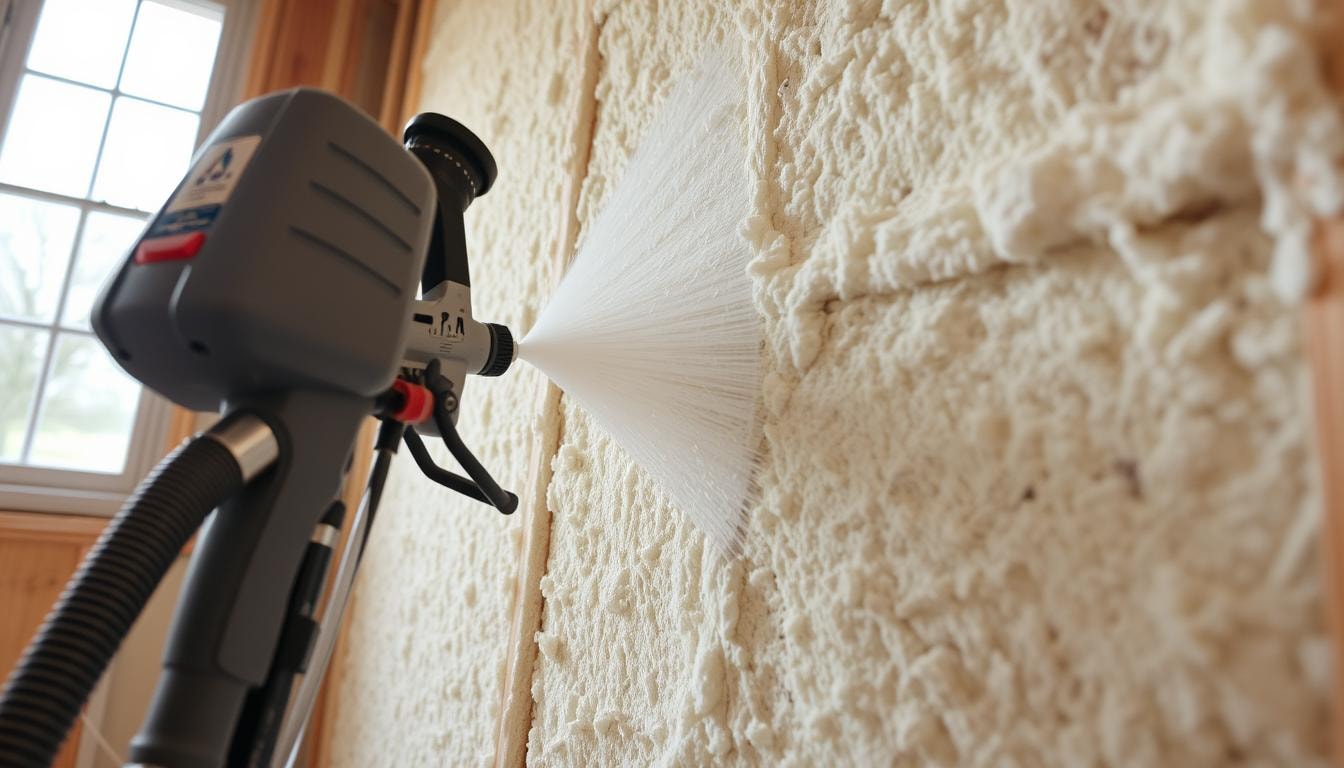Spray Foam Insulation Near You
Can’t find what you are looking for?
How It Works
-
Answer a few questions about your home project.
-
Within seconds, get matched with top-rated local pros.
-
Compare quotes and choose the best pro for the job.
Spray Foam Insulation In Your Area
Spray Foam Insulation: The Best Choice for Your Home
Meta Description: Discover why spray foam insulation is the superior choice for your home. Learn about its benefits, types, and how it can enhance energy efficiency and comfort.

Spray foam insulation is changing how we insulate our homes. It offers unmatched benefits for energy efficiency and comfort. This innovative solution protects your home from the elements better than traditional methods.
Key Takeaways
- Spray foam insulation offers superior R-values, providing unmatched thermal resistance compared to traditional insulation materials.
- Its air-sealing properties create an effective barrier against air infiltration, improving energy efficiency and indoor air quality.
- Spray foam insulation is highly durable and resistant to moisture, making it an ideal choice for homes in humid or damp environments.
- Professional installation is crucial to ensure proper application and maximize the long-term performance of spray foam insulation.
- While the upfront cost may be higher, spray foam insulation can deliver significant energy savings and increased home value over time.
What is Spray Foam Insulation?
Spray foam insulation boosts energy efficiency and comfort in homes. It comes in two main types: open-cell and closed-cell spray foam. Both offer unique benefits for different project needs.
Open-Cell Spray Foam Insulation
Open-cell spray foam is lightweight and flexible. It has small, connected air pockets that block air infiltration. This foam improves indoor air quality and reduces energy loss.
Open-cell foam has an R-value of 3.5 to 3.6 per inch. It’s great for filling wall cavities and other areas needing insulation.
Closed-Cell Spray Foam Insulation
Closed-cell spray foam has a denser structure with smaller, enclosed air pockets. It offers a higher insulation value of up to R-6.5 per inch. This makes it ideal for exterior insulation and areas needing maximum thermal resistance.
Closed-cell foam also acts as an effective vapor barrier. It traps moisture and prevents air leakage, adding extra protection to your home.
The choice between open-cell and closed-cell foam depends on your project’s needs. Consider factors like desired insulation value, budget, and moisture control requirements.
Benefits of Spray Foam Insulation
Spray foam insulation offers many advantages for homeowners. Its excellent coverage and air-sealing abilities stand out. The foam expands to fill tiny gaps, creating a solid barrier against air leaks.
Excellent Coverage and Air Sealing
This insulation helps maintain indoor temperatures, cutting energy use and costs. It also improves air quality by blocking allergens and pollutants from entering your home.
Long-Lasting and Durable
Spray foam insulation is known for its durability. It doesn’t break down or settle over time. This keeps its high R-value for decades, insulating homes effectively.
Homeowners can avoid frequent replacements, saving time and money. Spray foam’s coverage, air sealing, and durability make it a smart choice.
It boosts energy efficiency, comfort, and home value. This makes spray foam insulation a wise investment for any homeowner.
High Insulation Value and Energy Efficiency
Spray foam insulation boasts exceptional insulating properties. It’s a top choice for homeowners looking to boost energy efficiency. With a high R-value, it effectively traps heat and prevents air leaks.
The airtight seal of spray foam insulation is key to saving energy. It keeps temperatures consistent throughout the home. This reduces strain on HVAC systems, potentially shrinking their size by up to 35%.
Spray foam excels in extreme temperatures. Closed-cell foam retains heat in cold climates and blocks heat in warm regions. This versatility makes it valuable for improving home energy efficiency everywhere.
Spray foam insulation can also provide cool roof performance. It reflects sunlight and cuts air conditioning needs. This can lead to significant energy savings and a longer-lasting roof.
In sum, spray foam insulation stands out for energy-conscious homeowners. It reduces energy use and utility costs while boosting comfort and sustainability.
Moisture and Air Barrier Properties
Spray foam insulation offers exceptional insulation and robust moisture and air barrier capabilities. Closed-cell spray foam acts as a powerful vapor barrier. It prevents moisture movement and shields against air infiltration, enhancing home comfort and energy efficiency.
Closed-Cell Foam as a Vapor Barrier
Closed-cell spray foam insulation has a dense, rigid structure that blocks air and moisture. It doesn’t need a separate vapor barrier, making it ideal for regions with such requirements.
This insulation type is great for flood-prone or humid areas. It protects building materials from moisture, preserving structural integrity and preventing mold growth.
Closed-cell foam’s moisture-blocking ability can trap water if there’s an existing issue. Experts like Foam Bear Orlando can advise on vapor barrier needs for specific insulation types.
Soundproofing Capabilities
Spray foam insulation is a top choice for improving home soundproofing. Both open-cell and closed-cell spray foam effectively reduce noise transmission. They enhance acoustic performance in living spaces.
Open-cell spray foam excels in sound absorption. Its Sound Transmission Class (STC) rating ranges from 40 to 50. This type significantly deadens sound transfer between rooms and floors.
Closed-cell spray foam offers even better soundproofing. Its STC ratings can reach up to 60. This makes it a superior option for noise reduction.
Spray foam outperforms traditional insulation materials. Fiberglass and Rockwool have STC ratings of 39 and 45, respectively. A 10 STC improvement can cut unwanted sound by 50%.
Certified attic specialists recommend open-cell spray foam for attics. It reduces noise and keeps out pollen and contaminants. Closed-cell foam excels in heat insulation and moisture control.
Spray foam creates a seamless, airtight barrier. It blocks unwanted noise from entering your home. This ensures a quieter, more peaceful living environment.
Spray foam insulation is ideal for minimizing outside noise. It also reduces sound transfer between floors. Choose spray foam for your soundproofing needs.
Spray Foam Insulation Installation
Proper installation is key for spray foam insulation’s performance. The process involves spraying liquid foam onto surfaces. It then expands and hardens into a solid layer. DIY spray foam kits are available for small projects. However, professionals are recommended for larger installations.
Experts have the skills to apply foam correctly. They can also handle the mess and safety issues involved. Professional installers use specialized equipment and training. This ensures even application and proper thickness.
Professional vs. DIY Installation
DIY kits offer a cheaper option for small projects. But they need careful attention to detail and safety measures. Proper curing of spray foam is crucial. The foam must fully harden and expand within 24 to 48 hours.
This allows it to reach maximum insulating properties. Rushing the curing process can lead to poor performance. Incorrect application may cause issues later on.
Cost of Spray Foam Insulation

Spray foam insulation costs vary based on type and project scope. Open-cell foam costs $0.45-$0.65 per board foot. Closed-cell foam is pricier at $1-$1.50 per board foot.
Professional installation ranges from $1,300 to $4,000, averaging around $2,500. Total costs for spray foam insulation projects can span from $600 to $10,000.
Open-cell foam costs $1-$3 per square foot. Closed-cell foam runs $1.50-$4 per square foot. A 2,000-square-foot house may cost $2,000-$8,000 to insulate.
Spray foam insulation’s higher cost can be offset by long-term energy savings. Its superior performance often justifies the initial investment.
Homeowners should weigh the costs and benefits when choosing insulation. This helps determine the best solution for their specific needs.
Environmental Concerns with Spray Foam Insulation
Spray foam insulation offers great benefits, but it has environmental drawbacks. The main issue is the high global warming potential (GWP) of blowing agents. These agents, like hydrofluorocarbons (HFCs), are used in traditional spray foam.
Blowing agents can have GWPs in the thousands. This can negate the energy efficiency benefits of spray foam. It’s a major concern for global warming and the environmental impact of this insulation.
Low-GWP and Plant-Based Alternatives
Some makers have created low-GWP or plant-based alternatives to traditional blowing agents. These include soybean-based foams using water as the blowing agent. They have a much lower global warming potential.
Homeowners can also look into eco-friendly insulation options made from recycled materials. These choices can help reduce their carbon footprint.
Spray foam can be effective in some cases. However, it’s crucial to consider the environmental concerns. Look into sustainable and renewable insulation options for a greener home.
Comparing Spray Foam Insulation to Other Types
Spray foam insulation offers unique advantages over fiberglass, mineral wool, and cellulose. It provides a higher R-value per inch, ensuring superior insulation performance. Spray foam also creates an effective air and moisture barrier, outperforming other insulation materials.
Open-cell spray foam has an R-value of 3.5 to 3.6 per inch. Closed-cell spray foam boasts an R-value of about 6 per inch. Fiberglass batts and loose-fill fiberglass provide up to 4.3 R-value per inch.
Spray foam’s higher insulation value leads to greater energy efficiency and cost savings. However, it comes with a higher upfront cost compared to other insulation materials. Homeowners must weigh these factors when choosing the best insulation solution.
Fiberglass batt insulation is more cost-effective and comes in pre-cut standard sizes. This makes it easier to install in traditional construction. Cellulose insulation, made from recycled paper, suits older homes well.
Your choice between spray foam and other insulation types depends on several factors. Consider desired R-values, air-sealing needs, moisture resistance, and budget. Understanding each option’s features helps you make the best decision for your home.
Spray Foam Insulation for Specific Applications

Spray foam insulation is a versatile solution for homes. It can be applied in walls, ceilings, roofs, basements, and crawl spaces. It expands to fill small gaps, making it ideal for these areas.
Walls, Ceilings, and Roofs
Spray foam creates an airtight seal in wall cavities. This prevents air infiltration and improves energy efficiency. Its high R-values help maintain comfortable temperatures throughout the home.
It’s also great for insulating ceilings and roofs. Spray foam provides superior thermal and moisture barrier properties in these areas.
Basements and Crawl Spaces
Spray foam insulation excels in basements and crawl spaces. It helps prevent moisture-related issues by blocking outside air entry. This reduces water vapor infiltration and potential mold growth.
Different types of spray foam offer varying benefits. Open-cell and closed-cell foams have different thermal resistance and moisture barrier properties. This allows for customized solutions in each space.
Tips for Hiring Spray Foam Insulation Experts
Hiring professionals for spray foam insulation is often the best choice. The process is complex and needs special skills. Professional contractors have the right tools and know-how to apply foam correctly.
Here are some tips to consider when hiring spray foam insulation experts:
- Look for contractors with proper licensing, insurance, and a track record of successful projects. This ensures they have the necessary expertise and operate safely.
- Communicate clearly and consistently with the contractor, particularly if you have local builders or commercial projects. Establishing trust and rapport can lead to more referrals.
- Prioritize contractors who maintain a neat and tidy workspace, as this can influence the perception of the quality of their work.
- Face-to-face interactions can help build customer loyalty and differentiate the contractor from competitors. An elevator speech that quickly communicates their value proposition can also enhance sales efficiency.
- Educating prospects on the benefits of spray foam insulation, such as its excellent coverage, air sealing, and long-lasting durability, can foster trust and credibility.
- Leveraging technology like Reactor Connect can demonstrate the contractor’s professionalism and quality control measures.
These tips help homeowners find skilled and trustworthy spray foam insulation experts. A good choice leads to a safe and successful installation. It also means less mess and disruption in your home.
Discover FindPros for Your Spray Foam Insulation Needs
Are you looking to install the highest R-value spray foam insulation for your basement walls, exterior walls, or even your loft? FindPros can help you find the best local professionals to handle the job, even in wet conditions. Simply answer a few questions about your home project, and we’ll match you with top-rated contractors who will compete to provide you with the most competitive pricing. Take the guesswork out of finding the right spray foam insulation expert that you feel comfortable working with. Get started with FindPros today and enjoy a stress-free insulation installation process.
Conclusion
Spray foam insulation offers many benefits for homeowners. It provides superior insulation, effective sealing, and enhanced soundproofing. This comprehensive solution improves home comfort and energy efficiency.
The upfront cost is higher than traditional insulation types. However, long-term savings on heating and cooling can offset this investment. These savings often occur within a few years.
Homeowners should consider the pros and cons of spray foam insulation. Environmental concerns and professional installation are important factors. Understanding open-cell and closed-cell spray foam helps make informed decisions.
Evaluate project requirements and priorities before choosing spray foam insulation. Consider both short-term and long-term benefits. This careful approach ensures the best choice for your home.
Making an informed decision leads to improved comfort and energy savings. It also enhances your indoor environment. Spray foam insulation can provide these benefits when used appropriately.
Frequently Asked Questions (Spray Foam Insulation)
MOST POPULAR CITIES
Browse by State- Alameda
- Costa Mesa
- Laguna Beach
- Orange
- Alhambra
- Culver City
- Lancaster
- Oroville
- Anaheim
- Daly City
- Livermore
- Oxnard
- Antioch
- Davis
- Lodi
- Pacific Grove
- Arcadia
- Downey
- Lompoc
- Palm Springs
- Bakersfield
- El Centro
- Long Beach
- Palmdale
- Barstow
- El Cerrito
- Los Angeles
- Palo Alto
- Belmont
- El Monte
- Malibu
- Pasadena
- Berkeley
- Escondido
- Martinez
- Petaluma
- Beverly Hills
- Eureka
- Marysville
- Pomona
- Brea
- Fairfield
- Menlo Park
- Port Hueneme
- Buena Park
- Fontana
- Merced
- Rancho Cucamonga
- Burbank
- Fremont
- Modesto
- Red Bluff
- Calexico
- Fresno
- Monterey
- Redding
- Calistoga
- Fullerton
- Mountain View
- Redlands
- Carlsbad
- Garden Grove
- Napa
- Redondo Beach
- Carmel
- Glendale
- Needles
- Redwood City
- Chico
- Hayward
- Newport Beach
- Richmond
- Chula Vista
- Hollywood
- Norwalk
- Riverside
- Claremont
- Huntington Beach
- Novato
- Roseville
- Compton
- Indio
- Oakland
- Sacramento
- Concord
- Inglewood
- Oceanside
- Salinas
- Corona
- Irvine
- Ojai
- San Bernardino
- Coronado
- La Habra
- Ontario
- San Clemente